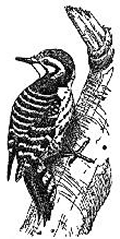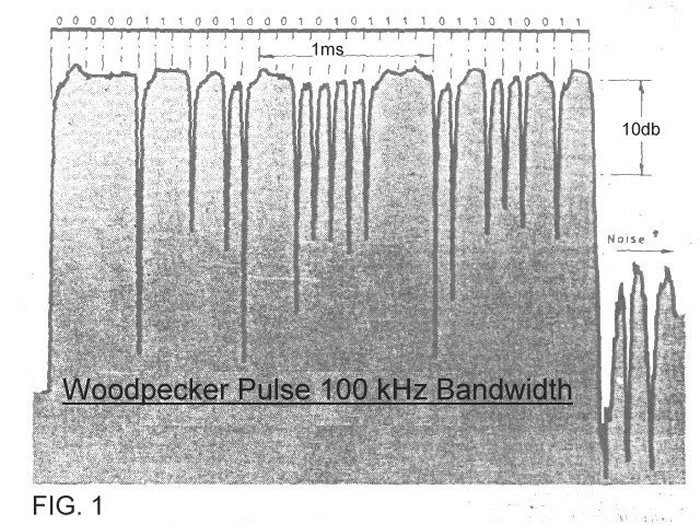Mystery Signals of the Short Wave
Dedicated to the more unusual, strange, bizarre and apparently meaningless signals on the short wave bands !
From the Archives
Russian Woodpecker | Yosemite Sam |
Site Information
What's New | About Me | Email |
From the Archives
WOODPECKER
By J. P. Martinez G3PLX
A letter Published in WIRELESS WORLD - APRIL 1982

As a radio amateur, I have often been annoyed by the Russian "woodpecker" pulse transmissions which have plagued the h.f. bands for many years (1). There has been no official explanation of the purpose of these transmissions, and various theories have been expounded in the media, ranging from spy communications to death rays. However, as a result of accidentally coming across some of these signals on a laboratory spectrum analyser, and storing the waveforms on a transient recorder, I think I can shed a bit more light on their structure and purpose.
Figure 1 is based on a printout of a typical pulse, plotted as logarithmic amplitude versus time. The overall duration of the pulse is 3.l ms. The interesting feature is the presence of "glitches" in the top of the pulse, the pattern of which remains the same from pulse to pulse, and they occur at intervals which are multiples of 100 microseconds. This led me to suppose that the glitches formed a binary sequence of length 31 bits.
I also guessed that the glitches arose from phase reversals in the transmitted signal, the finite width of the glitches resulting from the effect of the finite bandwidth of the transmitter and/or spectrum analyser. Thus, arbitrarily assigning a zero to the first data bit, the original modulation pattern could be reconstructed, with 0 representing 0 degrees and 1 representing 180 degrees. This gave the pattern 0000011100100010101111011010011.

This sequence turns out to be a maximum-length, pseudo-random binary (p.r.b.) sequence(2), which can be generated by a 5-bit shift register with feedback formed from the parity function of the contents of stages 3 and 5. I subsequently observed other pulse transmissions with different sequences of the same length, and was able to match these to p.r.b. codes from shift registers with feedback from stages (2,5), (2,3,4,5) and (1,2,3,5). Four different codes, implying four different transmitters, agreeing with observations previously reported(1).
The interesting point about this use of p.r.b. codes arises from the shape of their autocorrelation function. If such a sequence is compared bit-for-bit, with a shifted version of itself, at all possible shifts, then, apart from the position where all 31 bits match, at all other shifts no more than one bit matches between the two sequences. Thus, if a woodpecker pulse is fed through a 3.1 ms delay line with 31 equally spaced taps, and the outputs of the taps are vectorially combined with appropriate inversions, so that the inversion pattern itself is the same sequence as the transmitted phase-inversion sequence, then the combined output will be a single pulse of 100 microseconds duration, 31 times the amplitude of the input signal, with virtually no sidelobes.
The conclusion from all this, it seems to me, is that the woodpecker must be simply a pulse compression radar system, with a resolution of 100 microseconds (10 miles), but the sensitivity 31 times that of a 100 microseconds radar of the same power. Not only does the p.r.b. sequence cancel out shifted versions of itself in order to achieve its performance, but it has a high immunity to other codes in the same family, thus reducing cross-interference between separately sited radars on the same frequency. The use of four different sites presumably enables the target to be pinpointed in three dimensions in spite of the poor directivity of h.f. antennas and the variabilities of the ionosphere which is used to extend the range beyond the horizon.
Although this information leads to the possibility of jamming these signals, or at least puzzling the distant radar operator, whether we shall ever be rid of these wretched signals is another matter altogether.
J. P. Martinez G3PLX Gosport. UK.References
(1) Mystery Soviet over-the-horizon tests. Wireless World, February 1977 p.53.
(2). Pseudo-random binary sequence generators. F. Butler, Wireless World, February 1975 p.87.
CORRECTION: When I contacted Peter Martinez with regard to this article he kindly pointed out an error which was corrected in a later issue of the magazine.
The pulse compression gain is not 31 times but the square-root of 31.
I am most grateful to Peter Martinez for allowing me to include his work on this page, and to Chris Kirk, NV1E,Shrewsbury, Massachusetts,USA, who kindly provided me with a copy of the original letter and scan of the Woodpecker waveform.